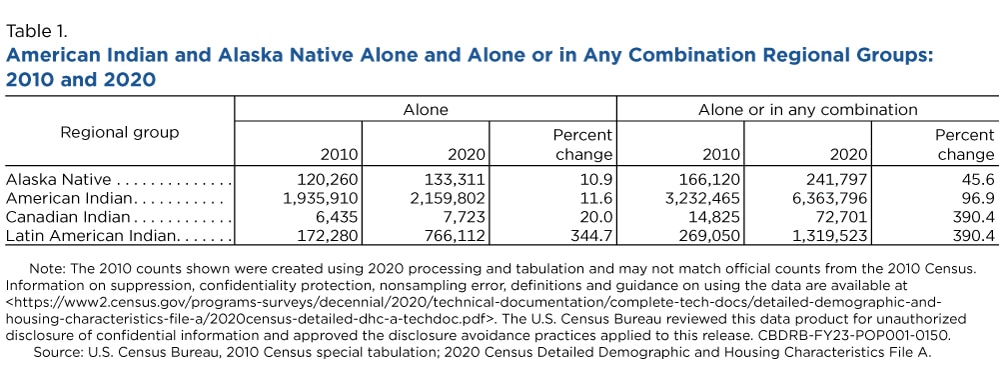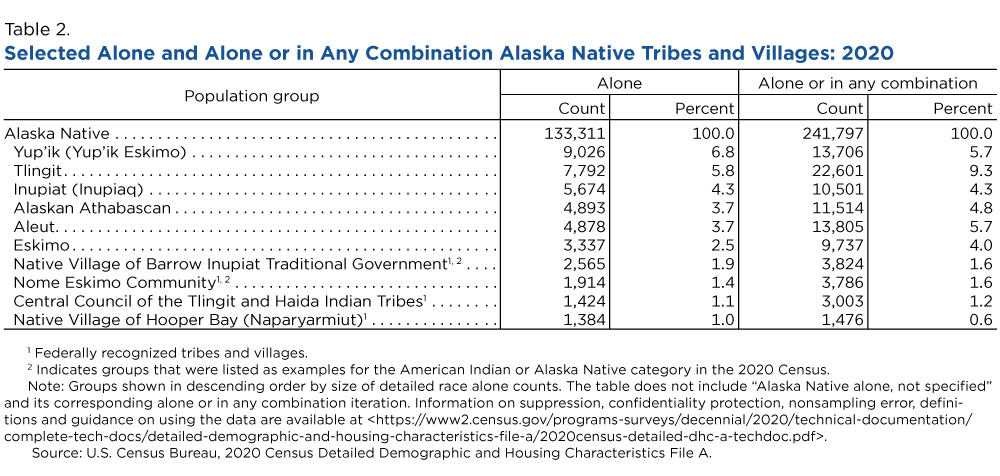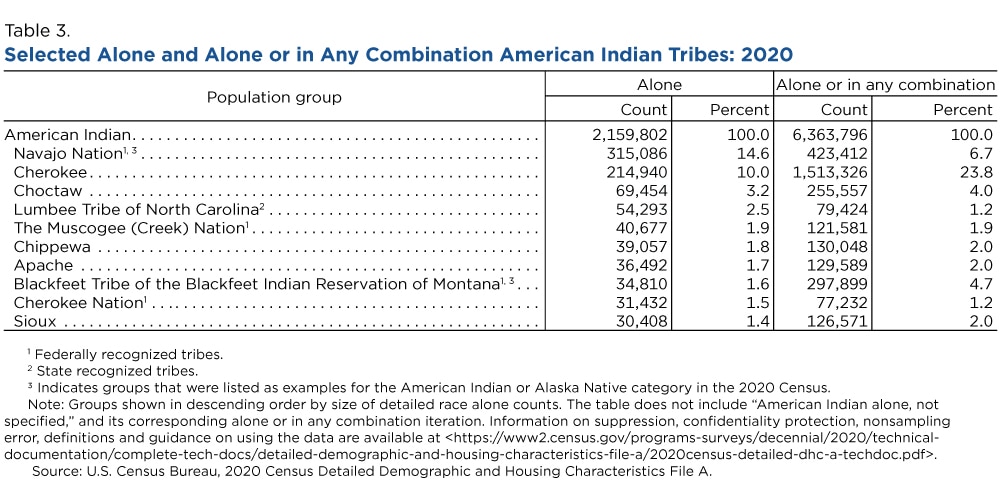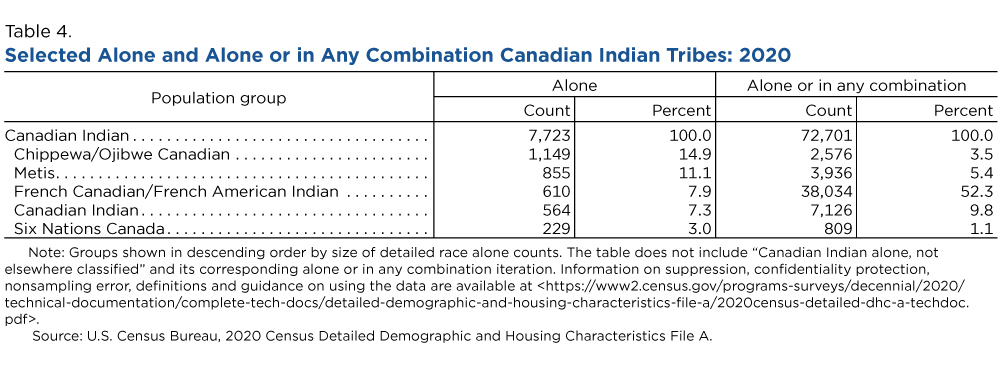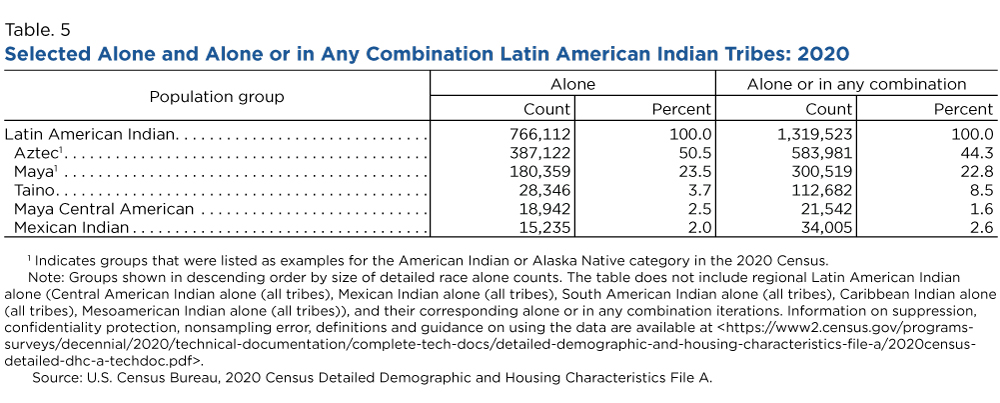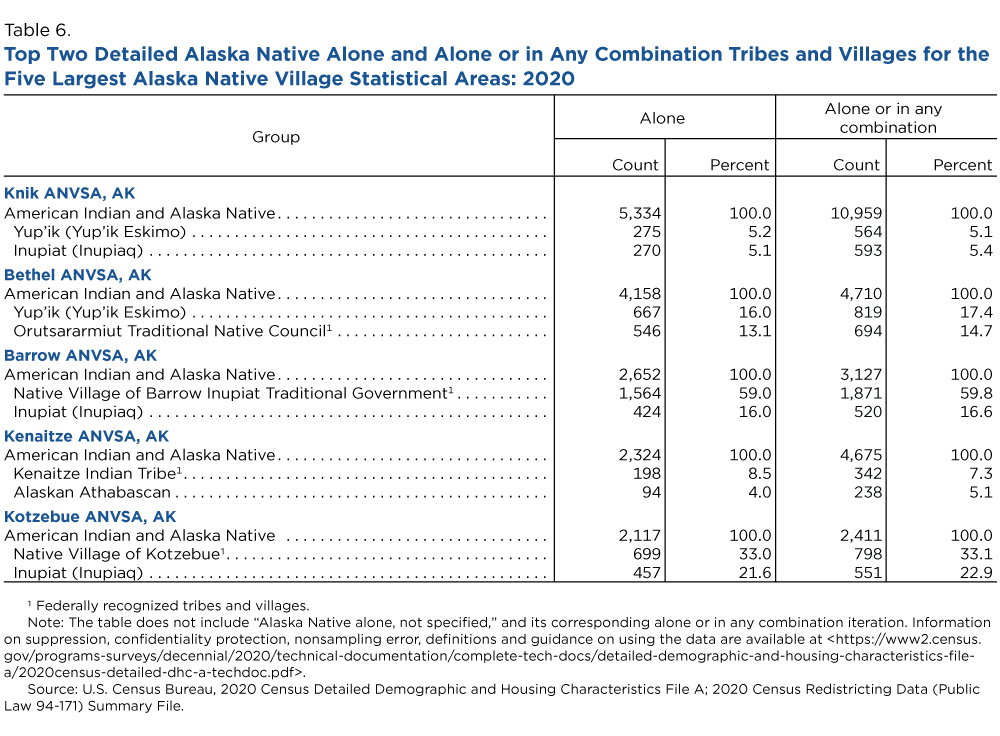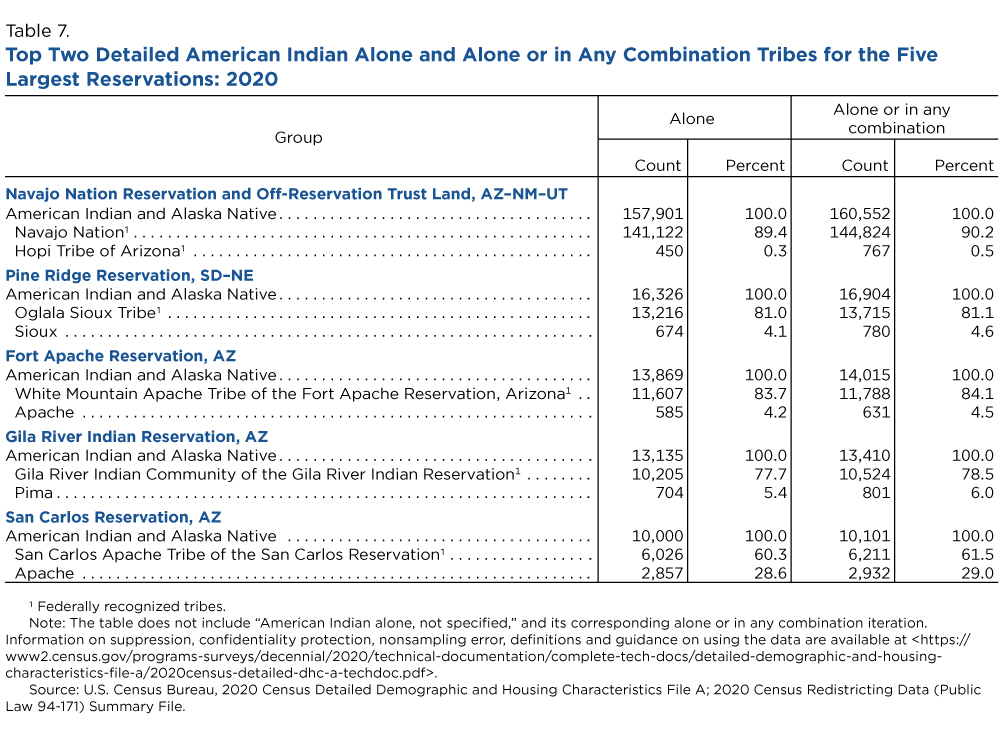A Look at the Largest American Indian and Alaska Native Tribes and Villages in the Nation, Tribal Areas and States
Navajo Nation was the most frequent response among people who identified as a single detailed American Indian group in the 2020 Census, according to new data recently released by the Census Bureau.
The 2020 Census collected data for a diverse range of American Indian and Alaska Native (AIAN) responses, including federally and state recognized tribes and villages as well as those that did not represent a specific recognized tribe.
Over half (50.9%) of the American Indian alone population lived in five states; Oklahoma had the largest American Indian alone population (14.2%), followed by Arizona (12.9%), California (9.9%), New Mexico (9.1%) and Texas (4.8%).
In this article, we present race alone and race alone or in any combination data tabulated from the AIAN write-in responses to the 2020 Census race question.
The race alone population includes respondents who reported only one response, such as Native Village of Barrow Inupiat Traditional Government, and no other response.
The race alone or in any combination population includes individuals who gave one response, such as Native Village of Barrow Inupiat Traditional Government, and those who reported multiple responses like Native Village of Barrow Inupiat Traditional Government and Arctic Slope Corporation or Native Village of Barrow Inupiat Traditional Government and Black or African American.
These data are important to frame the discussion of racial and ethnic composition and help us understand our country’s changing demographics as it becomes more multiracial.
National Findings
We focus on four broad categories of the AIAN population: American Indian, Alaska Native, Canadian Indian and Latin American Indian.
From 2010 to 2020:
- The Alaska Native alone population grew 10.9% to 133,311, while the Alaska Native alone or in any combination population increased 45.6% to 241,797 (Table 1).
- The American Indian alone population grew 11.6% to 2,159,802, while the alone or in any combination population nearly doubled, increasing to 6,363,796.
- The Canadian Indian alone population grew 20.0% to 7,723, while the alone or in any combination population soared 390.4% to 72,701, an increase over 19 times larger than the jump in the alone population.
- The Latin American Indian alone population rose 344.7% to 766,112, while the Latin American Indian alone or in any combination population went up 390.4% to 1,319,523.
The largest Alaska Native alone group in the United States in 2020 was Yup'ik (Yup'ik Eskimo) with 9,026 people or 6.8% of the total Alaska Native alone population. The largest Alaska Native alone or in any combination group was Tlingit with 22,601 people or 9.3% of the Alaska Native alone or in any combination population (Table 2).
Among federally recognized tribes, the three largest Alaska Native alone tribes and villages were the Native Village of Barrow Inupiat Traditional Government (1.9%), the Nome Eskimo Community (1.4%) and the Central Council of the Tlingit and Haida Indian Tribes (1.1%).
The Navajo Nation made up the largest share of the American Indian alone population (14.6%), followed by Cherokee (10.0%), Choctaw (3.2%) and the Lumbee Tribe of North Carolina (2.5%) (Table 3).
Cherokee made up the largest share of the American Indian alone or in any combination population (23.8%), followed by the Navajo Nation (6.7%), Blackfeet Tribe of the Blackfeet Indian Reservation of Montana (4.7%) and Choctaw (4.0%).
Chippewa/Ojibwe Canadian made up the largest share (14.9%) of the Canadian Indian alone population, while French Canadian/French American Indian made up the largest share (52.3%) of the Canadian Indian alone or in any combination population (Table 4).
Aztec and Maya, which were added as new examples on the questionnaire for the AIAN category for the 2020 Census, made up 74.0% of the Latin American Indian alone population and 67.1% of the Latin American Indian alone or in any combination population (Table 5).
Two of the top five Latin American Indian groups were Mexican Indian (Aztec and Mexican Indian). Together they made up over half (52.5%) of the Latin American Indian alone and 46.8% of all the Latin American Indian alone or in any combination populations.
Alaska Natives Living in Alaska Native Village Statistical Areas
Among the Alaska Native Village Statistical Areas (ANVSAs), the Knik ANVSA had the largest AIAN alone and AIAN alone or in any combination populations.
The largest Alaska Native alone group in Knik ANVSA was the Yup’ik (Yup’ik Eskimo), with 5.2%, followed by Inupiat (Inupiaq) with 5.1%. Over 20% of the AIAN alone population in Knik ANVSA reported “Alaska Native” without providing a detailed race response.
In Barrow ANVSA, 59.0% of the AIAN alone population identified as Native Village of Barrow Inupiat Traditional Government, followed by 16.0% identifying as Inupiat (Inupiaq).
American Indians Living on Reservations
In 2020, the five largest American Indian reservations were all west of the Mississippi River (Table 7). On four of the top five reservations, a single tribe in each reservation made up at least 77% of the AIAN alone responses.
Distribution of AIAN population on reservations:
- Over 4% of the AIAN alone population in the United States lived on the Navajo Nation Reservation and Off-Reservation Trust Area. This is nearly 10 times more American Indians and Alaska Natives than the second largest reservation in size. Almost 90% of the AIAN population on the Navajo Nation Reservation and Off-Reservation Trust Area identified as Navajo Nation alone.
- The Oglala Sioux Tribe alone accounted for 81.0% of the AIAN alone population on the Pine Ridge Reservation. Similarly, 83.7% of the AIAN alone population on the Fort Apache Reservation identified as White Mountain Apache Tribe of the Fort Apache Reservation, Arizona alone; 77.7% of the Gila River Indian Reservation identified as Gila River Indian Community of the Gila River Indian Reservation alone.
- In the San Carlos Reservation, 60.3% of the AIAN alone population identified as San Carlos Apache Tribe of the San Carlos Reservation alone, while 28.6% responded Apache alone.
State Data
The distributions of the broad AIAN categories varied widely by state in 2020:
- Over 77% of the Alaska Native alone population resided in Alaska (Figure 1). Washington had the second largest Alaska Native alone population (6.0%), followed by California (2.5%), Oregon (1.8%) and Texas (1.4%).
- Over half (50.9%) of the American Indian alone population lived in five states; Oklahoma had the largest American Indian alone population (14.2%), followed by Arizona (12.9%), California (9.9%), New Mexico (9.1%) and Texas (4.8%).
- Nearly a third (32.7%) of the Latin American Indian alone population lived in California, followed by Texas (11.6%), New York (8.1%), Illinois (6.3%) and Florida (4.6%).

The Detailed Races and Ethnicities in the United States and Puerto Rico: 2020 Census data visualization provides more information about the 2020 population size of all detailed AIAN alone and alone or in any combination tribes and villages for the nation, states and counties.
Data comparisons between the 2020 Census and 2010 Census race data should be made with caution, taking into account improvements we made to the race question and the ways we coded what people told us.
Data Visualization
Related Information
The Technical Documentation [PDF 10.6 MB] provides more information on data quality and how the Census Bureau collects, codes and tabulates statistics on race and Hispanic or Latino origin.
Information on the application of differential privacy and data accuracy for the 2020 Census at various levels of geography are available on the 2020 Census Data Products: Disclosure Avoidance Modernization webpage.
2020 Census Detailed Demographic and Housing Characteristics File A on America Counts
9/21
9/26
10/3
10/10
10/17
10/24
Subscribe
Our email newsletter is sent out on the day we publish a story. Get an alert directly in your inbox to read, share and blog about our newest stories.
Contact our Public Information Office for media inquiries or interviews.



